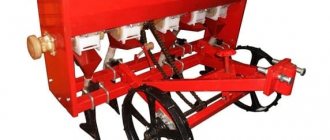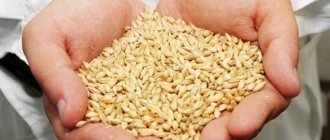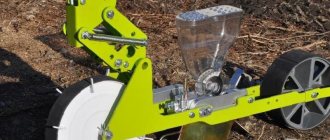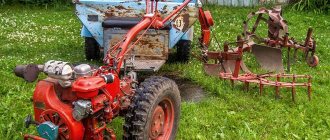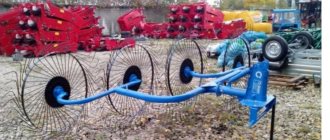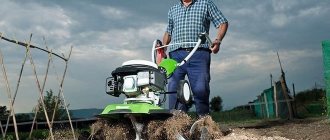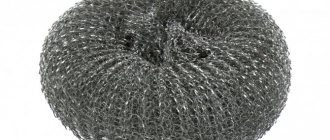A modern seeder on a walk-behind tractor is a device that allows you to plant seeds of garlic, onions, corn and other crops, saving the farmer’s time and effort.
The design of the seeder is quite simple, which allows you to make it yourself. Let’s talk in more detail about what is required for this and how to make the equipment yourself.
Seeder to walk-behind tractor - operating principle of the device
The garlic cutter for a walk-behind tractor works on a very simple principle.
The main design elements include the chain drive and rear wheel, which function as a single unit. The transmission acts on the wheel and sets it in motion, causing the seeds to fall to the ground. All planting material is contained in a special bunker, pre-designed for sowing simultaneously in all rows. In modern seeders, you can adjust the speed of sowing seeds and the size of their bulbs. Thanks to this, the farmer also has the opportunity to increase or decrease the number of plantings. Different models of seeders allow you to adjust the sowing depth, which, as a rule, varies from zero to several centimeters.
In cases where carrot seeds or other small planting material are to be planted, the farmer can use fillers. You can use various cereals or bran as them. However, river sand cannot be used for this purpose, as it can damage fragile seeds.
Types and descriptions of seeders for walk-behind tractors
Planting garlic and other crops with a walk-behind tractor can be done with different seeders. Below we will consider the design features of each type of seeders for walk-behind tractors in more detail.
Row seeders
Devices of this kind are used for row sowing and simultaneous placement of seeds into the soil.
Depending on the purpose, on sale there is a row seeder for a walk-behind tractor for garlic, a corn seeder for a walk-behind tractor, and a universal row seeder, which is suitable for sowing seeds of any crops. The main elements of row seeders on a walk-behind tractor are coulters and sowing devices. The coulters are equipped with special “legs” or chains, which are necessary for embedding seeds into the ground. For operation in areas with heavy soils, row seeders with disc coulters are used, and for use on loose soil, devices with anchor coulters are used. The main advantages of row seeders include the uniformity of sowing and the optimal depth of placement of planting material.
Nest seeders
Devices of this kind are optimally suited in cases where the farmer needs to sow crops precisely into holes or nests prepared in advance.
Nest seeders for walk-behind tractors can be successfully used for sowing seeds of garlic, onions and other small planting material. The advantages of nest seeders for walk-behind tractors include ease of use. Such equipment is characterized by small dimensions and weight. However, this type of seeders is very slow, which is why it takes a lot of time to work with them.
Square nest seeders
These grain seeders for walk-behind tractors make nests at pre-marked points in conventional squares or rectangles.
Such structures consist of a frame, support wheels, a mechanism for unwinding measuring wire from a reel and sowing sections. The advantages of these devices for a walk-behind tractor include the ability to cover a large area of territory when working. Among the disadvantages of such seeders is their large mass due to the presence of a large number of metal elements in their design. These seeders are not capable of developing high speed, which leads to loss of time when working with it.
Broadcast seeders
Devices of this type have a simple and reliable design, do not require special care and rarely require repairs.
The principle of operation of broadcast seeders on a walk-behind tractor is very simple: during operation, seeds taken by a special disk are subject to pressure, as a result of which they are thrown out of the seeder onto the site. The advantages of such devices include high productivity. Among the disadvantages, it is worth highlighting the difficulties when using seeders at the edge of the plot, in which most of the seeds are thrown outside the garden.
Dotted seeders
These devices are used for sowing seeds of garlic, onions, corn and legumes in pre-prepared nests, which are located at a certain distance from each other.
Despite the complex design and large dimensions, dotted seeders for walk-behind tractors are quite easy to operate. The advantages of such devices include high precision during sowing and good productivity. Among the disadvantages, we should highlight the inability to use such seeders in areas with heavy clay soil.
What types of seeders are there?
Regardless of whether it is a factory seeder or a homemade one, they are all classified according to the method of sowing and the principle of operation. According to the method of sowing they are:
- nesting;
- privates;
- dotted;
- scattering;
- square-nested.
Based on the principle of operation, they are distinguished: universal and highly specialized, designed for sowing one crop or one group of crops - grain, corn, etc. To work in garden plots, it is preferable to use universal models that are capable of sowing seeds of both grain crops and vegetables into the soil. Farmers prefer to use highly specialized units that correspond to the specialization of their activities.
But, both for farmers and for household plots, the accuracy of seed sowing is of great importance. Therefore, the most economical of the seeders, the dotted one or, as it is more often called, the precision seeder, has become the most popular in recent years.
Homemade seeder for walk-behind tractor - do-it-yourself options
There are several ways to make a seeder for a walk-behind tractor. When choosing a method, be sure to consider your capabilities and experience in working with equipment. Next, we will consider each of the methods in more detail.
Row seeder on a walk-behind tractor - a simple manufacturing method
Just before you start making a simple seeder for a walk-behind tractor, be sure to study the drawings. They will tell you the dimensions of the parts, the method of their fastening and the correct procedure for assembly.
Next, you should prepare materials and tools. To work you will need:
- steel sheets, no more than 5 mm thick;
- 3 metal disks;
- steel pipe;
- wooden block;
- bicycle chain;
- 3 small wheels;
- bolts and screws;
- welding machine;
- hacksaw for metal;
- electric drill bits;
- multi-sheet plywood.
The manufacturing algorithm is as follows:
- To begin, weld the U-shaped frame of the seeder as shown in the diagram. To make it, take sheet iron, 52.5 cm long and 11.5 cm wide;
- At the top of the frame, install a seed hopper in the form of a box, which can be made from multi-layer plywood;
- Install a seeding device inside the bunker, which should be mounted on two plain bearings. The device itself should be shaped like a shaft and resemble a spool for winding thread. It can be made from a piece of wood and varnished;
- Then take a steel pipe that will serve as an axis and place 3 metal disks on it, which should be fixed at the same distance from each other;
- Drill 12 holes in the rim of one of the disks into which the seeds will fall. When the seeder starts working, this disk with holes made in it will fall into the bunker with planting material. The captured seeds will then fall into furrows placed directly in front of the seeder discs. To rotate the disk, put a bicycle chain on it, the other end of which is secured to the rotor of the walk-behind tractor engine;
- Next, at the rear of the seeder frame, weld a horizontal piece of steel sheet, which is necessary for embedding the seeds into the soil;
- After this, 3 wheels must be attached to the bottom of the structure. The front wheel can be taken from an old baby stroller, and the two rear wheels can be taken from a children's bicycle. The video will tell you more about making a simple row seeder.
A self-made seed drill is equally suitable for sowing garlic or corn seeds. In the process of moving the device along a previously plowed area, the seeder reel begins to rotate, which occurs due to the presence of a bicycle chain. The seeds that are in the hopper are scooped up by the cells of the coil, after which they are moved into the funnel of the seed tube, and from there into the ground.
Precision nest seeder for walk-behind tractor - a more complex assembly method
As in the first case, before starting work, study the detailed diagram, which will help to avoid errors during assembly.
A nest seeder should consist of several basic elements. You will need:
- 2 wheels for moving around the site;
- seed hopper;
- seeding roller;
- 2 bearings;
- handle with bracket;
- 2 brackets required for mounting the opener.
The manufacturing procedure is as follows:
- You can make a bunker from wooden boards, approximately 1.5 cm thick. For the bottom of the bunker, use several sheet steel bushes welded to each other. Connect the walls of the box lengthwise and crosswise with self-tapping screws, steel angles or tenons. Install 1.5 cm thick wooden pads at the bottom of the bunker walls. Use nails or screws to secure them. In the rear part of the seeder hopper, attach a bracket through which the device will be connected to the walk-behind tractor;
- To install the seeding roller in the walls and trims, make semicircular cutouts. Next, attach the fixing brackets to the overlays with screws. To ensure that when sowing the seeds fall exactly in the intended places, install several rubber plates in the inclined bottoms;
- The wheels of the seeder must have a diameter of at least 20 cm. To fasten them, use hubs 6 cm long. Make holes in the hubs, which should be the same size as the holes in the seeding roller;
- To make the opener, use sheet steel 1.5 mm thick. Next, attach the element using brackets. Make several holes on one of the brackets - they will be needed to adjust the depth at which the seeds will be sown. To adjust this setting, you will need to move the opener from one hole to another.
A seeder made in this way will help you quickly plant seeds of garlic, onions, corn and legumes. In this case, the seed will fall exactly into the pre-prepared holes.
Manufacturers and their models
We list some manufacturers of this equipment that deserve respect:
- Zirka.
- "Centaur".
- "BELINSKSELMASH"
- Premium.
- BOZKURT.
- JSC “Red Star”.
- Becker Aeromat.
- Amazone.
- Yarilo, etc.
The most popular models are:
Vacuum walk-behind seeder SVTV 4-8
- Seeder operating speed 2.5 km/h
- Seeding drum speed up to 21 rpm.
- Number of rows of seeds sown per sowing drum 2 rows
- The permissible number of installed seeding drums is from 1 to 4
- The size of the sown seeds is from 1 to 10 mm.
- The distance between the sowing rows is adjustable no more than 70 cm.
- The distance between the sown seeds in the row is adjusted depending on the type of seeds
- The depth of seed placement in the soil is 100 mm.
Precision seeder STV-4
Precision seed drill STV-2
- Types of drums:
- 3 mm - carrots, onions, radishes
- 6 mm beets, tomatoes, peppers, eggplant
- 8 mm - cucumber, soy, zucchini
- 10 mm - peas, green beans
- 16 mm – onion sets, watermelon
- 18 mm - corn
- Hopper capacity 3l
- Row spacing 16-50cm
- Sowing depth 1-6 mm
- Track width 110mm
- Weight 40 kg
